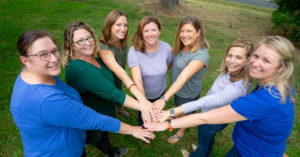Celebrating Independence…and Interdependence
 This month we have been celebrating INDEPENDENCE! Our nation has a special adoration for independence which is honored and celebrated each July with all things red, white and blue, backyard BBQs, special patriotic traditions, and firework extravaganzas.
This month we have been celebrating INDEPENDENCE! Our nation has a special adoration for independence which is honored and celebrated each July with all things red, white and blue, backyard BBQs, special patriotic traditions, and firework extravaganzas.
Our culture also places great value on the process of becoming, remaining, or restoring independence. The profession of Occupational Therapy is rooted in the work of helping to improve an individual’s level of function and independence. Occupational Therapists work with those of all ages to enhance or restore function and independence through the use of meaningful activities. The word “Occupation” is not used to refer specifically to a job, but rather the daily activities that bring purpose, meaning, connection, and quality to our daily lives. There is a special sense of pride and accomplishment that is experienced when a new level of mastery and independence is achieved (ie, visualize the child that rides their bicycle independently for the first time, the adolescent that begins driving a vehicle independently, or an adult that works diligently to regain use of their left arm after a stroke so that they can wrap their grandchild in a bear hug).
Our culture tends to associate the meaning of independence with freedom. Freedom from dependency on others. A sense of self-sufficiency and pride in what can be accomplished with hard work, repetition, and perseverance. Occupational Therapists are trained to adapt and “grade” activities (increase or decrease the level of difficulty) to provide the “just right challenge” that promotes skill development and independence. The trick to finding the “just right challenge” is finding the balance between challenging an individual enough to build their skills (and therefore confidence and motivation to continue)…but not too much that it leads to frustration, overwhelm, or giving up on the activity. Finding that “just right challenge” can be tricky…but it can also be so much fun and very rewarding.
It is important to note, however, that with a culture that values (even at times idolizes) independence, there can be negative associations with those that have difficulty gaining independence in certain skills or those that lose their independence from an injury, illness or the aging process. Asking for help, needing assistance from others, or requiring more time to complete daily activities can become negatively and falsely viewed as symbols of weakness. And when those that have difficulty improving their level of independence feel that their slower or less proficient performance is viewed negatively by others, it impacts their motivation, leading to frustration, overwhelm, or shutdown. In addition, with recent isolation from others throughout our communities and frustrations around the implications of the pandemic, it has become common to hear comments such as “I am just going to stay in my own lane” or “I just need to focus on myself and my own family”. These are comments that are the result of fatigue and frustration that so many have been enduring for far too long. It is hard to sustain healthy relationships with others when functioning from a place of fatigue and/or frustration. So with our celebration of INDEPENDENCE, let’s also increase our awareness and value of INTERDEPENDENCE to build stable and resilient families and communities.
INTERDEPENDENCE is a term used to describe when two or more individuals or groups rely on each other (ie, if your dog provides you with love and happiness, and you provide your dog with food and walks–and love and happiness, then your relationship with your dog is one of interdependence). When we think of previous generations living in small towns with limited transportation means, we might visualize the interdependence that was required to trade goods among one another throughout the community (ie, the butcher, the baker, the candlestick maker). On the contrary, in current times, large grocery stores, box stores, and Amazon make it easy for individuals throughout our communities to function independently of one another, purchasing their goods in one main location or having items drop shipped to their doorstep with minimal to no interaction with others. A diminished and undervalued importance of interdependence has negative implications on our youth and the health of our communities that is necessary for healthy growth, development, and social-emotional stability and connection.
So let’s discover tangible strategies that can be incorporated into daily activities to help kids (and families) develop and promote independence and interdependence within their homes and communities:
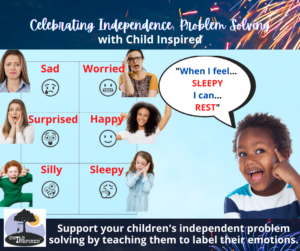 Label Feelings: Support your child’s independence with Problem-Solving skills by working on Emotional Regulation and Impulse Control. A first step — help in their early years to label feelings (yours and theirs). Lots of resources have great visual depictions of emotions (board books, cards, toy characters). A fun way to practice is by modeling or role-playing the emotions with your child while having him/her point to or verbalize the corresponding emotion on the visual. After labeling the emotions, discuss reactions that pair to the emotions appropriately- such as resting when sleepy, asking for a hug when sad, sharing a smile when happy, or making a fist and then relaxing when worried. Remember to label your own emotions during daily conversation. Ex. “I’m disappointed it’s raining and we can’t go to the park.’’, “I’m sad grandma isn’t feeling well”, “I’m excited for your birthday party!” These activities can help your child build independence with identifying and communicating their feelings, and asking for support or help to solve problems.
Label Feelings: Support your child’s independence with Problem-Solving skills by working on Emotional Regulation and Impulse Control. A first step — help in their early years to label feelings (yours and theirs). Lots of resources have great visual depictions of emotions (board books, cards, toy characters). A fun way to practice is by modeling or role-playing the emotions with your child while having him/her point to or verbalize the corresponding emotion on the visual. After labeling the emotions, discuss reactions that pair to the emotions appropriately- such as resting when sleepy, asking for a hug when sad, sharing a smile when happy, or making a fist and then relaxing when worried. Remember to label your own emotions during daily conversation. Ex. “I’m disappointed it’s raining and we can’t go to the park.’’, “I’m sad grandma isn’t feeling well”, “I’m excited for your birthday party!” These activities can help your child build independence with identifying and communicating their feelings, and asking for support or help to solve problems.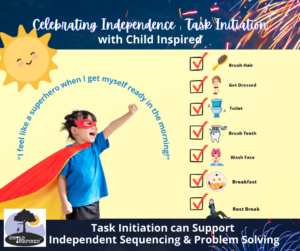 Support your child’s independence with Task Initiation skills by prompting them to start their day with a morning checklist. Visual schedules are a great tool to help kids independently move through daily routines. These schedules can be created to include specific steps to a routine. For example, have a separate visual schedule at the bathroom sink for brushing teeth. This could include pictures for wetting the tooth brush, applying toothpaste, brushing while singing the ABC Song 2 times, rinsing, and putting items away. (Tip: Laminating this schedule will allow it to last longer!) While building your child’s confidence and independence, you are encouraging healthy habits on the checklist- such as brushing teeth. It may take several repetitions with assistance before your child can complete the sequence independently, but the work is worth the wait! And super important- praise, praise, praise when they complete certain steps independently.
Support your child’s independence with Task Initiation skills by prompting them to start their day with a morning checklist. Visual schedules are a great tool to help kids independently move through daily routines. These schedules can be created to include specific steps to a routine. For example, have a separate visual schedule at the bathroom sink for brushing teeth. This could include pictures for wetting the tooth brush, applying toothpaste, brushing while singing the ABC Song 2 times, rinsing, and putting items away. (Tip: Laminating this schedule will allow it to last longer!) While building your child’s confidence and independence, you are encouraging healthy habits on the checklist- such as brushing teeth. It may take several repetitions with assistance before your child can complete the sequence independently, but the work is worth the wait! And super important- praise, praise, praise when they complete certain steps independently.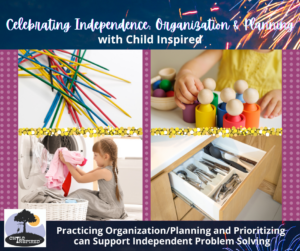 Support your child’s independence with Organization and Planning skills by incorporating some easy tasks into your daily routines. When considering household chores for your child, include a variety of jobs that include sorting: matching socks, unloading the silverware (remove sharps) from the dishwasher, sorting and storing Legos by the same size or color, sorting darks and lights into two laundry baskets and pushing them down the hallway, putting his/her clothes away in the proper dresser drawer, etc. When playing, include games that include matching colors/numbers (Candy Land, Uno), distinguishing similarities and differences (Memory, Zingo), or involve planning/strategy to win/complete (Go Fish, Guess Who). Puzzles, shape sorting cubes, or pick-up sticks are great options for kids of different ages and stages. Encouraging multi-step activities and projects that involve 1-Pre-Planning… 2-Prioritizing… and 3-Organizing can help your kiddo develop important executive function skills that support their ability to independently solve everyday challenges and tasks.
Support your child’s independence with Organization and Planning skills by incorporating some easy tasks into your daily routines. When considering household chores for your child, include a variety of jobs that include sorting: matching socks, unloading the silverware (remove sharps) from the dishwasher, sorting and storing Legos by the same size or color, sorting darks and lights into two laundry baskets and pushing them down the hallway, putting his/her clothes away in the proper dresser drawer, etc. When playing, include games that include matching colors/numbers (Candy Land, Uno), distinguishing similarities and differences (Memory, Zingo), or involve planning/strategy to win/complete (Go Fish, Guess Who). Puzzles, shape sorting cubes, or pick-up sticks are great options for kids of different ages and stages. Encouraging multi-step activities and projects that involve 1-Pre-Planning… 2-Prioritizing… and 3-Organizing can help your kiddo develop important executive function skills that support their ability to independently solve everyday challenges and tasks. Support your child’s independence with Working Memory skills. Working Memory affects how we learn. It helps us stay focused when there are distractions. Working Memory involves recall of visual and verbal information. Examples include the ability to listen to a sequence of events in a story while trying to understand what the story means, and remembering a set of instructions and then carrying out the task. A fun family activity such as a multi-step “Simon Says” game can support your child’s Working Memory skills! By practicing listening, processing, remembering multiple steps in instruction…then interpreting those directions…and then responding with a corresponding movement, your child will improve their ability to integrate information that they received, stored in “working memory”, and then acted upon. “Simon says, ‘raise your hands and wave them in the air’” or “Simon says, ‘touch your nose and then pat your head.’” These two-step instructions may lead to three-step instructions, and so on.
Support your child’s independence with Working Memory skills. Working Memory affects how we learn. It helps us stay focused when there are distractions. Working Memory involves recall of visual and verbal information. Examples include the ability to listen to a sequence of events in a story while trying to understand what the story means, and remembering a set of instructions and then carrying out the task. A fun family activity such as a multi-step “Simon Says” game can support your child’s Working Memory skills! By practicing listening, processing, remembering multiple steps in instruction…then interpreting those directions…and then responding with a corresponding movement, your child will improve their ability to integrate information that they received, stored in “working memory”, and then acted upon. “Simon says, ‘raise your hands and wave them in the air’” or “Simon says, ‘touch your nose and then pat your head.’” These two-step instructions may lead to three-step instructions, and so on. Support your child’s independence with Dressing skills. Getting Dressed- a Life Skill that we encourage our children to do independently. But sometimes, kids with coordination challenges or clothing sensitivities can need more support with this task. Is it difficult for your child to go through the sequence of getting dressed because of coordination or attention challenges? Providing choices that “meet them where they are at” will avoid unnecessary stressors and encourage comfortable progress: loose-fitting clothes that have larger neck holes and elastic band waists, slip-on shoes, and jackets with simple or no fasteners. In a neutral and low stress moment, practice with them! Lay out their clothing (2-3 items) and a doll to dress – laying out the doll’s clothing nearby, in a separate pile. Start with the doll: “Can you help Dolly put on her shorts?” “Now can you put on your shorts to match Dolly?” Alternate slowly, giving one direction at a time. Include lots of praise with every successful effort. This “dress Dolly, dress yourself” practice will create a positive association with dressing, alleviating some stress and instilling confidence for future attempts. Do certain types of clothing cause irritation? Are certain parts of clothing (tags, fabric texture, sleeves, sock seams) too uncomfortable to tolerate, leading to tantrums or frequent clothing removal? Try to select clothing options that are comfortable (soft, cotton, seamless, tag-less, tight). Children who seek proprioceptive input often prefer clothing that is snug vs loose, as tighter clothing helps give them the extra ‘hug’ they are craving. Allow them to select their clothing choices (limited choices between 2 items for young children) and lay them out for the next morning. Choose your battles: It is ok to let their clothing choices be selective. It is ok if they wear the same shirt twice or even three times a week. The important thing is that they are comfortable, confident, secure… and dressed!
Support your child’s independence with Dressing skills. Getting Dressed- a Life Skill that we encourage our children to do independently. But sometimes, kids with coordination challenges or clothing sensitivities can need more support with this task. Is it difficult for your child to go through the sequence of getting dressed because of coordination or attention challenges? Providing choices that “meet them where they are at” will avoid unnecessary stressors and encourage comfortable progress: loose-fitting clothes that have larger neck holes and elastic band waists, slip-on shoes, and jackets with simple or no fasteners. In a neutral and low stress moment, practice with them! Lay out their clothing (2-3 items) and a doll to dress – laying out the doll’s clothing nearby, in a separate pile. Start with the doll: “Can you help Dolly put on her shorts?” “Now can you put on your shorts to match Dolly?” Alternate slowly, giving one direction at a time. Include lots of praise with every successful effort. This “dress Dolly, dress yourself” practice will create a positive association with dressing, alleviating some stress and instilling confidence for future attempts. Do certain types of clothing cause irritation? Are certain parts of clothing (tags, fabric texture, sleeves, sock seams) too uncomfortable to tolerate, leading to tantrums or frequent clothing removal? Try to select clothing options that are comfortable (soft, cotton, seamless, tag-less, tight). Children who seek proprioceptive input often prefer clothing that is snug vs loose, as tighter clothing helps give them the extra ‘hug’ they are craving. Allow them to select their clothing choices (limited choices between 2 items for young children) and lay them out for the next morning. Choose your battles: It is ok to let their clothing choices be selective. It is ok if they wear the same shirt twice or even three times a week. The important thing is that they are comfortable, confident, secure… and dressed! Support your child’s independence with Grooming skills: brushing teeth, trimming nails, combing hair. If your child is intolerant of a toothbrush in her mouth or has a gaging response, independent toothbrushing will require practice. When she is in a regulated state, and it is the typical time to brush teeth, try using a warm, wet washcloth to help desensitize her face and gums. Start by massaging her face with the washcloth- spending extra time around the jaw region. Eventually, work on lips and front teeth. Progress from there- as comfortable- until you can offer a toothbrush for her lips and teeth. Softer bristles are easier to tolerate and they may even prefer an electric toothbrush with gentle vibration.
Support your child’s independence with Grooming skills: brushing teeth, trimming nails, combing hair. If your child is intolerant of a toothbrush in her mouth or has a gaging response, independent toothbrushing will require practice. When she is in a regulated state, and it is the typical time to brush teeth, try using a warm, wet washcloth to help desensitize her face and gums. Start by massaging her face with the washcloth- spending extra time around the jaw region. Eventually, work on lips and front teeth. Progress from there- as comfortable- until you can offer a toothbrush for her lips and teeth. Softer bristles are easier to tolerate and they may even prefer an electric toothbrush with gentle vibration.
Does your child refuse or get extremely upset with the thought or attempt of trimming nails? Choose your words- you are “trimming” not “cutting.” Role-modeling with a dolly may make the act less scary. Allowing your kiddo to pretend to trim Dolly’s nails may be reassuring. To desensitize the nails, make a fun “spa” experience and soak their nails in water prior to massaging nails dry with a towel and attempting to trim one nail at a time- with frequent breaks if needed, and music playing as a positive distraction from the sound of nails being trimmed. If your child has a low tolerance for hair brushing, we recommend desensitizing, creating a positive association and encouraging independence. To desensitize the neck and scalp, try massaging these areas during neutral times (ie when watching movies together). Use deep and slow pressure, being sure to have him focused on something other than the motion. Create a positive association by allowing him to brush your hair first. PRAISE successful attempts. With more independence in these practices, the more your child’s self-confidence and self-concept will shine! Support your child’s independence with Toileting. Gain an understanding of your child’s readiness. Start with exposure and keep your expectations developmentally-appropriate. Ask a trusted source when you need guidance. For toddlers, begin with positive interactions in the bathroom. Does your young child see you use the potty? Label your actions (“Mommy went pee-pee in the toilet”). Can they help you flush the toilet and wash hands together? Putting a plastic potty next to the big toilet can encourage your child to imitate what you are modeling. Set reasonable expectations. A game plan with an “all-in”, one week timeframe can create unnecessary stress. Start with one daily activity that you can add a toileting attempt to (ie, while bath water is running prior to bath time). When you start to see success, add another (ie, after breakfast), so they learn to control (and release) bladder/bowels during daily routines. At first, praise them for sitting on the potty regardless of the outcome. Use a timer and praise them for “waiting”! Sand timers are great visual timers to encourage 1-2 minutes of waiting. While waiting, sing songs, but please try to leave technology out of the bathroom. Don’t force them to sit until they pee/poop. Controlling those muscles takes practice and coordination. Celebrate successes with excitement! If your child is struggling to gain mastery with toileting, talk with a pediatrician. Maybe there are sensory sensitivities impacting their willingness to try (ie, the sound of the toilet flushing, difficulty tolerating a different wiping method than diapering). Maybe there are other developmental considerations (ie communication, attention, muscle tone, GI sensitivities) that might be interfering. So regardless of pace, keep in mind that it’s not a race!
Support your child’s independence with Toileting. Gain an understanding of your child’s readiness. Start with exposure and keep your expectations developmentally-appropriate. Ask a trusted source when you need guidance. For toddlers, begin with positive interactions in the bathroom. Does your young child see you use the potty? Label your actions (“Mommy went pee-pee in the toilet”). Can they help you flush the toilet and wash hands together? Putting a plastic potty next to the big toilet can encourage your child to imitate what you are modeling. Set reasonable expectations. A game plan with an “all-in”, one week timeframe can create unnecessary stress. Start with one daily activity that you can add a toileting attempt to (ie, while bath water is running prior to bath time). When you start to see success, add another (ie, after breakfast), so they learn to control (and release) bladder/bowels during daily routines. At first, praise them for sitting on the potty regardless of the outcome. Use a timer and praise them for “waiting”! Sand timers are great visual timers to encourage 1-2 minutes of waiting. While waiting, sing songs, but please try to leave technology out of the bathroom. Don’t force them to sit until they pee/poop. Controlling those muscles takes practice and coordination. Celebrate successes with excitement! If your child is struggling to gain mastery with toileting, talk with a pediatrician. Maybe there are sensory sensitivities impacting their willingness to try (ie, the sound of the toilet flushing, difficulty tolerating a different wiping method than diapering). Maybe there are other developmental considerations (ie communication, attention, muscle tone, GI sensitivities) that might be interfering. So regardless of pace, keep in mind that it’s not a race! Support your child’s independence with Sleeping skills! It’s a big step for your child to feel prepared and well-adjusted to sleep in other places during vacations, summer sleepovers, or their first overnight summer camp. Don’t rush it. Establish and promote good sleep routines at home before taking it on the move! Get into a consistent habit of turning down the volume on the radio/tv in the evening and the brightness on any technology or overhead lighting (love dimmer switches) about an hour prior to initiating your child’s bedtime routine. Once the bedtime routine has been initiated, continue it steadily to reduce re-stimulating a child that is beginning to calm for bedtime (limiting playtime activities after bath time or changing into pajamas). Try to keep bedtime and wake up times consistent through the summer months, even if those timeframes are different than during the school year. Avoid letting your child stay up too late at night or sleep too late into the morning! Children still require the same amount of sleep each night to rest their bodies despite the longer hours of daylight… and often need even more rest when they have been physically active in the sun, heat, and water. Nighttime fears should be discussed during daytime, neutral times and addressed together as a family. Acknowledge a child’s worries or fears, but be mindful not to engage in too much dialogue or it may lead to perseveration (getting stuck) on the worry. Sometimes calming auditory stimuli like a sound machine with white noise or rain, or a soundtrack with gentle lullabies helps to promote sleep or reduce nighttime fears. Sometimes calming visual stimuli, like a nightlight that projects stars to the ceiling can be soothing. Weighted blankets can be calming by providing that “deep pressure”/hug sensation that helps to promote a feeling of safety and security (make sure weight is no more than 10% of your child’s weight). And having a transitional or security object (ie, stuffed animal or blanket) promotes self-soothing skills, particularly when sleeping in another, less familiar place.
Support your child’s independence with Sleeping skills! It’s a big step for your child to feel prepared and well-adjusted to sleep in other places during vacations, summer sleepovers, or their first overnight summer camp. Don’t rush it. Establish and promote good sleep routines at home before taking it on the move! Get into a consistent habit of turning down the volume on the radio/tv in the evening and the brightness on any technology or overhead lighting (love dimmer switches) about an hour prior to initiating your child’s bedtime routine. Once the bedtime routine has been initiated, continue it steadily to reduce re-stimulating a child that is beginning to calm for bedtime (limiting playtime activities after bath time or changing into pajamas). Try to keep bedtime and wake up times consistent through the summer months, even if those timeframes are different than during the school year. Avoid letting your child stay up too late at night or sleep too late into the morning! Children still require the same amount of sleep each night to rest their bodies despite the longer hours of daylight… and often need even more rest when they have been physically active in the sun, heat, and water. Nighttime fears should be discussed during daytime, neutral times and addressed together as a family. Acknowledge a child’s worries or fears, but be mindful not to engage in too much dialogue or it may lead to perseveration (getting stuck) on the worry. Sometimes calming auditory stimuli like a sound machine with white noise or rain, or a soundtrack with gentle lullabies helps to promote sleep or reduce nighttime fears. Sometimes calming visual stimuli, like a nightlight that projects stars to the ceiling can be soothing. Weighted blankets can be calming by providing that “deep pressure”/hug sensation that helps to promote a feeling of safety and security (make sure weight is no more than 10% of your child’s weight). And having a transitional or security object (ie, stuffed animal or blanket) promotes self-soothing skills, particularly when sleeping in another, less familiar place. Support your child’s independence and interdependence with Self-Advocacy skills, by supporting your child’s efforts to ask for help and accept help when needed. We want to encourage kids to solve problems, we also want them to be confident in themselves to know when they need a helping hand. Asking for help is nothing to be ashamed of- it doesn’t show weakness- quite the contrary. It is an act that is necessary when dealing with difficult or dangerous situations and practicing this skill will boost awareness and confidence.
Support your child’s independence and interdependence with Self-Advocacy skills, by supporting your child’s efforts to ask for help and accept help when needed. We want to encourage kids to solve problems, we also want them to be confident in themselves to know when they need a helping hand. Asking for help is nothing to be ashamed of- it doesn’t show weakness- quite the contrary. It is an act that is necessary when dealing with difficult or dangerous situations and practicing this skill will boost awareness and confidence.
Support your child with examples and modeling how to ask for help. Everyone responds differently to the feeling of needing assistance and it’s important for children to know that adults sometimes need help too. Think about your response when YOU need help and remember that little ones are watching and learning. When you see a child become overwhelmed and start to use words like, “I can’t do this! It’s too hard, or I quit!” encourage them to ‘pause’, validate their feelings, and guide them to find words to ask for help. Ex: “I can see your having trouble with that puzzle and that must be frustrating. I know you love puzzles so let’s take a pause and figure this out.” Work together to find ways to ask for help. Ex: “I’ve tried, and I’m still having a hard time. I feel like I need to take a break, but when I’m ready can you help me try again?” Children need guidance to find words and strategies when they’ve met their frustration threshold. This is a learned skill. Over time, they will learn to pause and ask for help on their own.
When out-and-about, point out the people and community helpers they can ask for help if needed: a lifeguard at the pool, a trusted neighbor in the neighborhood, a cash register associate at the store, a teacher at school, a police officer, etc.
Remember that although asking for help can sometimes be challenging, practicing and modeling this act can really be encouraging and promote the confidence needed to be successful.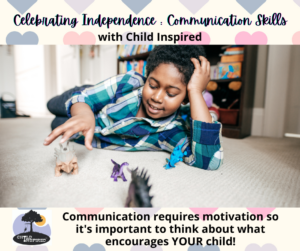 Support your child’s independence and interdependence with Communication skills. Communication is the ability to send (expressive) and receive (receptive) words, body language, eye contact, and feelings with another. We all want to teach our children how to communicate effectively so that they can be independent when expressing their wants and needs. We want to encourage our children to use their words, so that the guessing game behind the “why” is explainable. “Why are they crying? Why are they pulling on my leg? Why are they so fussy? Just tell me!” Many times, we are taught to ask our children to “Use your words!” But what if your children don’t know the words to say? We shouldn’t assume that they do. What if your children can’t speak when they are in a state of upset? We shouldn’t assume that they can.
Support your child’s independence and interdependence with Communication skills. Communication is the ability to send (expressive) and receive (receptive) words, body language, eye contact, and feelings with another. We all want to teach our children how to communicate effectively so that they can be independent when expressing their wants and needs. We want to encourage our children to use their words, so that the guessing game behind the “why” is explainable. “Why are they crying? Why are they pulling on my leg? Why are they so fussy? Just tell me!” Many times, we are taught to ask our children to “Use your words!” But what if your children don’t know the words to say? We shouldn’t assume that they do. What if your children can’t speak when they are in a state of upset? We shouldn’t assume that they can.
Instead of saying ‘what do you want?’ or ‘use your words!’, try giving visual and verbal choices by holding up 2 items. Encourage your child to point and reach as a method of communication while modeling the target language as the child receives the desired item. It is also important to focus on words that are functional such as high frequency words that are used across many contexts. Communication requires motivation so it’s important to think about what encourages YOUR child!” Support your child’s awareness of the Importance of Interdependence with these Fun Summer Outing Ideas:
Support your child’s awareness of the Importance of Interdependence with these Fun Summer Outing Ideas:
- Take your child to a play or CirqueD’Solei performance. Point out the stage hands that work to create a successful performance. Point out the music, lighting, set, costumes, supporting actors and actresses.
- Take your child to a concert or the orchestra. Point out the multiple musicians that must play their instruments in harmony together to create beautiful music. If they didn’t take turns and pause at the right moments, it would sound like noise instead of music.
- Spectate a team sporting event (football, soccer, lacrosse, field hockey) and teach your child to look at players in various positions on the field. Intentionally DON’T watch the ball. Share with your child how the other players coordinate their movements to strategically set-up and advance the play. Teams don’t win championships because of the lone work of an individual athlete, but because of the hard work and effort of many. The talent of one athlete can inspire others to develop their skill, but let’s not overlook that amazing athletes are often facilitated by other players that don’t always get the glory of securing the ball in the end-zone or goal cage.
Whatever your celebration of independence might entail for your child(ren) and family, or the children you serve, we hope it will offer opportunities to find joy in the process of developing new skills and increase your awareness and value of interdependence in building stable and resilient families and communities.
Authored by Christina Connors, Pediatric Occupational Therapist with contributions by Jenny Manning, Community Outreach Specialist and Child Inspired Team Members.
Child Inspired is an emerging family-centered, pediatric wellness practice in Southern Delaware. We are so proud of the inspiring group of pediatric therapists and educators that are working collaboratively to bring help and healing to children and families with outpatient therapy services and community outreach workshops. The Child Inspired team takes their work very seriously, but does make sure to sprinkle in moments of silliness and laughter, as we all need strategies to cope with the various challenges we must navigate.
Thanks for being part of our community! We’d love to hear from you!
